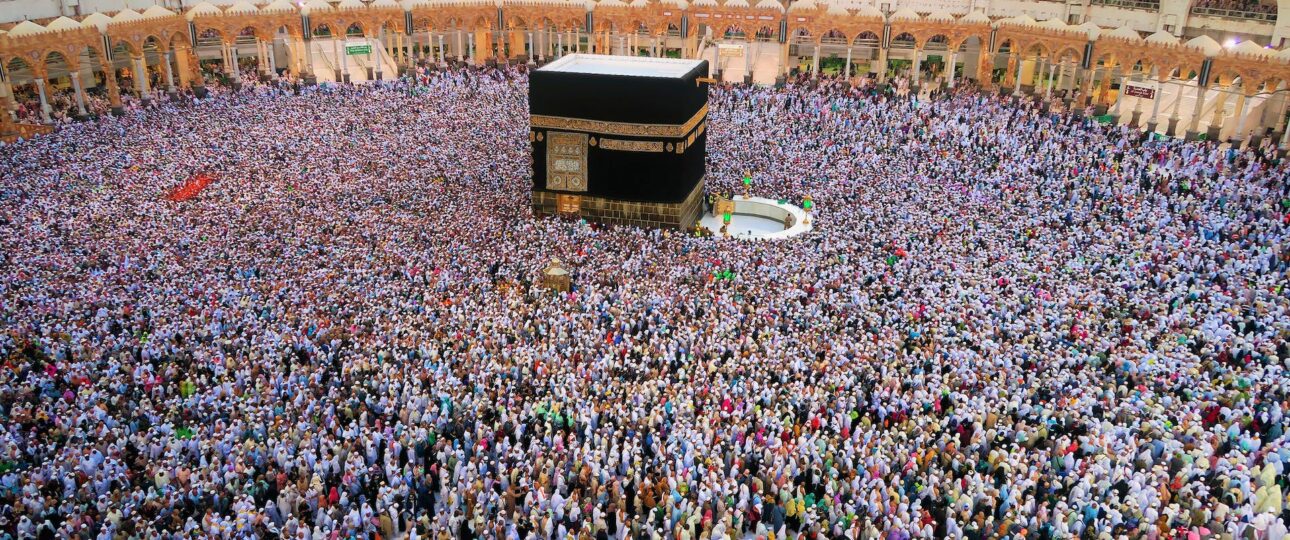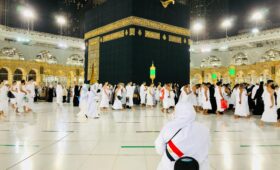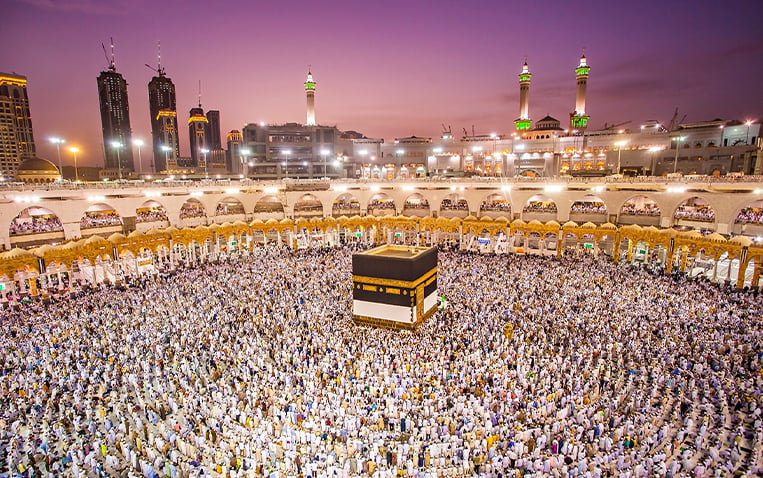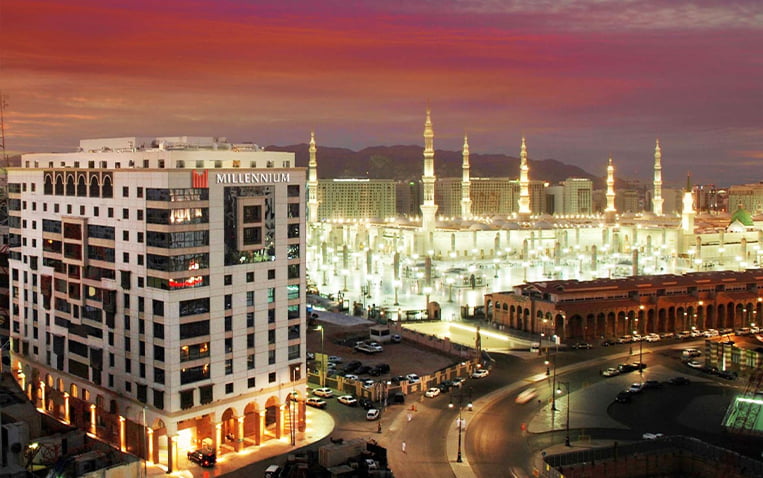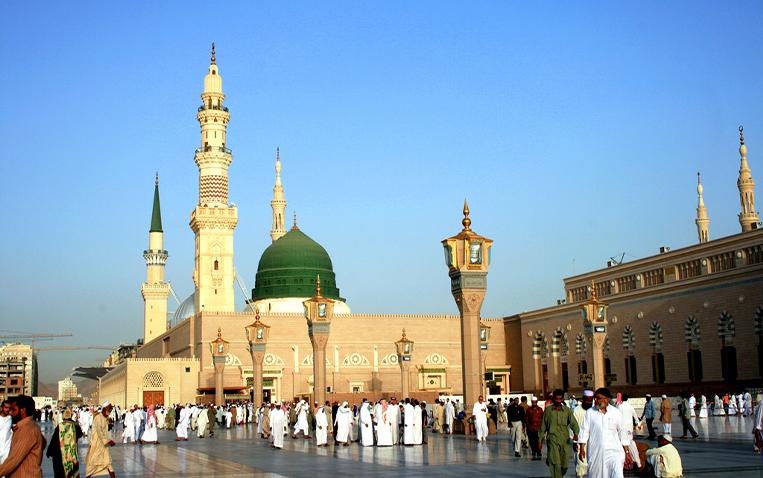What is Hajj?
Hajj is an important pilgrimage that all Muslims are required to undertake at least once during their lifetime, serving as one of Islam’s five pillars. Every year, millions of Muslims from across the globe come together and perform Hajj in Makkah.
Hajj is held annually during the Islamic lunar month of Dhul Hijjah, starting on the 8th day and lasting five or six days, depending on when a new crescent moon appears in sight. When this occurs, Muslims across the world celebrate Eid for three days as Eid al-Adha is celebrated.
Hajj is an annual Islamic pilgrimage that holds immense spiritual meaning for millions of Muslims around the world.
One of Islam’s Five Pillars, it is mandatory that physically and financially capable adult Muslims undertake this pilgrimage at least once during their lifetime.
Held annually during Dhu al-Hijjah month in Saudi Arabia’s Makkah city center during Dhu al-Hijjah month; Hajj commemorates Prophet Ibrahim (Abraham) and his family’s actions while emphasizing sacrifice, submission to God’s will, unity among Muslim ummah members as part of Hajj rituals.
Importance of Hajj
Islam places great emphasis on the Hajj, as it is one of the Five Pillars and requires eligible Muslims to make the pilgrimage at least once in their lifetime.
It is significant because it honors Prophet Ibrahim’s steadfast faith and obedience to Allah’s will, as represented by Mecca rituals.
As millions of Muslims come together to show their shared devotion and equality, the Hajj promotes harmony among Muslims around the world.
It is a deep spiritual journey that purifies the soul, asks for forgiveness, strengthens the bonds of community, and submits oneself to Allah’s will. A strong bond with Islamic history and values is established by the life-changing Hajj experience, which also promotes humility, personal development, and a revitalized dedication to religious beliefs.
What is done during Hajj?
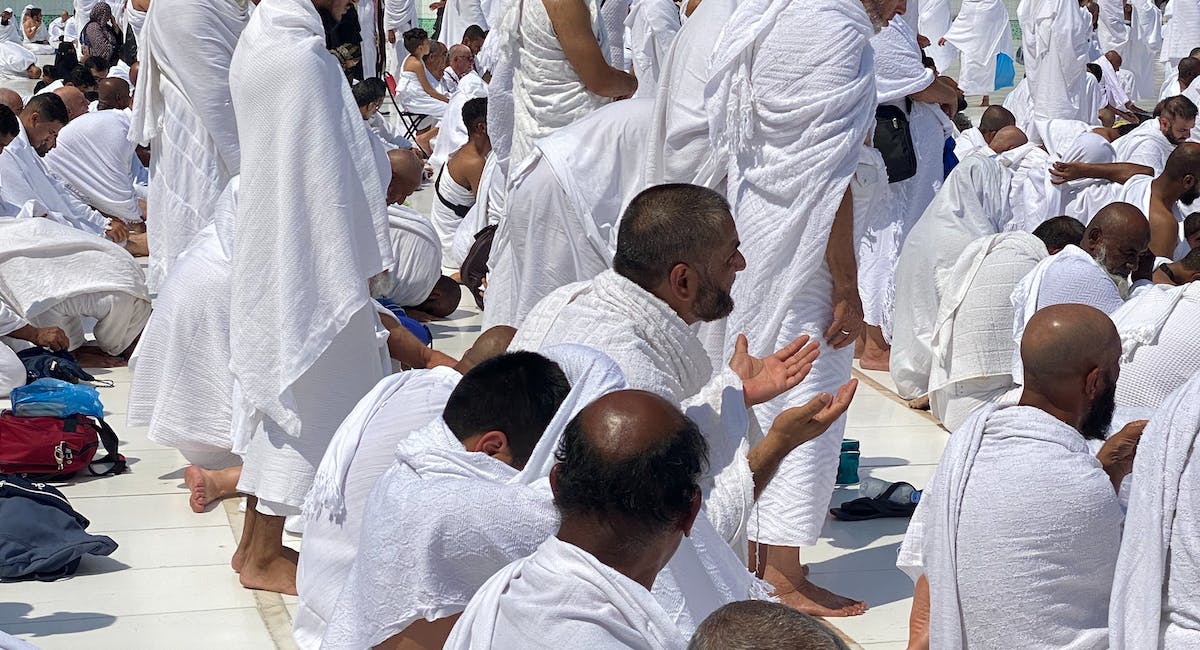
Hajj is an important pilgrimage in Islam that involves millions of Muslims annually performing rituals known as Hajj. When Hajj season rolls around, millions will gather together from around the globe in search of spiritual purification and closeness to Allah.
Each ritual holds deep symbolic meaning tied back to Prophet Ibrahim (Abraham), Hajar, and Isma’il from history; each ritual helps promote unity among Muslims while stressing sacrifice and submission to His will.
Hajj rituals include Tawaf and Sa’i:
Tawaf
Tawaf involves walking around Mecca’s Kaaba seven times to symbolize unity with Allah and their faith.
Sa’i
Sa’i involves walking seven times between Safa and Marwa hills – signifying Hajar’s search for water for her son Isma’il.
Pilgrims then proceed to Arafat Plain for prayer and reflection, seeking God’s forgiveness while throwing pebbles against pillars to symbolize rebuking Satan’s temptations.
Once pilgrims complete these rituals, they often celebrate the Eid al-Adha festival as a mark of commemoration for Ibrahim’s sacrifice of his son to Allah in obedience to Him.
Through such acts of pilgrimage, Hajj offers pilgrims a profound spiritual experience and fosters humility, self-discipline, and devotion among them.
What is Hajj in Islam?
Hajj is an annual pilgrimage consisting of numerous rituals and rites designed to provide spiritual, emotional, and physical challenges for participants.
Pilgrims should expect to walk anywhere between 5km-15km each day on this spiritual journey through Makkah and surrounding regions; much of this takes place at Masjid al-Haram where the Kaaba stands.
Hajj is an important spiritual obligation and pillar of Islam that many individuals will only ever take part in once during their lifetimes. Multiple trips may be made sincerely seeking Allah (SWT)’s pleasure if this is something that matters deeply to you.
As the Prophet Muhammad (peace and blessings be upon him) said:
“Whoever performs Hajj for the sake of Allah and does not utter any obscene speech or do any evil deed, will go back (free of sin) as his mother bore him.”
Rituals of Hajj
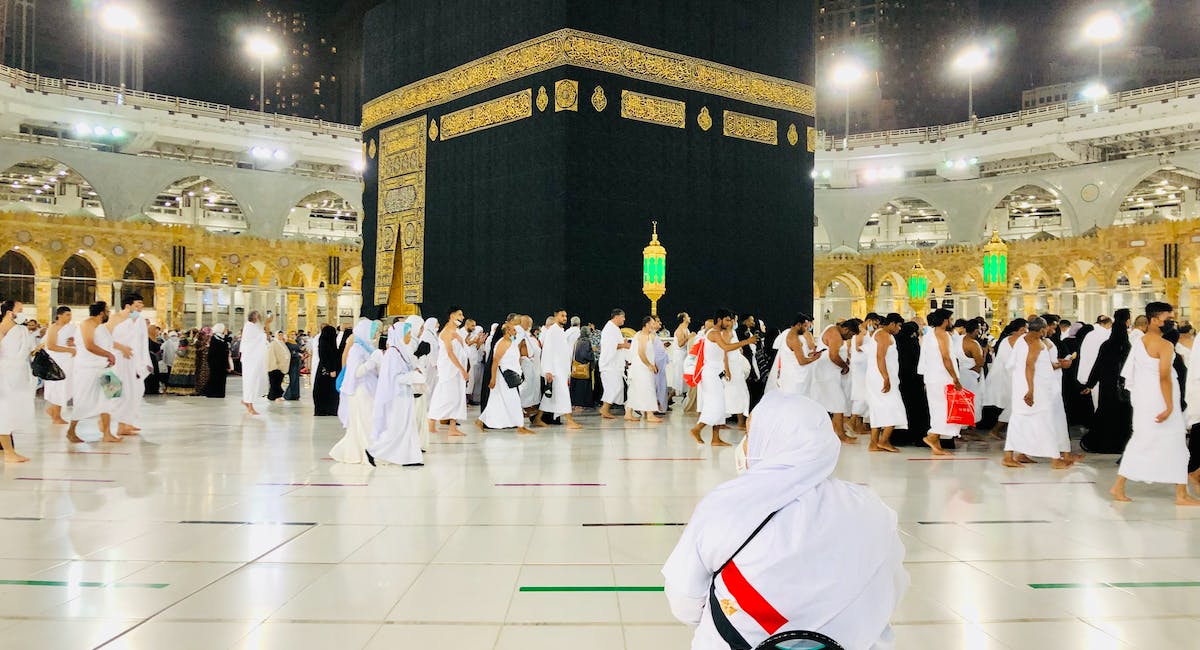
Hajj is an Islamic pilgrimage consisting of rituals and activities with deep spiritual significance for Muslims. This pilgrimage takes place over several days during Dhu al-Hijjah month.
These rituals collectively contribute to Hajj’s transformative and spiritually enriching experience, creating a deep bond between Allah and pilgrim, as well as greater cohesion among global Muslims.
Ihram, What Is Ihram?
Ihram is the state of religious consecration that pilgrims enter before commencing the physical journey of Hajj. Symbolizing purity and equality, participants wear white garments, symbolizing this state and purity.
In Ihram, participants adhere to certain rules, such as not cutting hair or nails, using perfume, and engaging in certain behaviors that create focus or maintain humility.
Tawaf
Tawaf, the circumambulation of Kaaba (sacred structure at the center of Masjid al-Haram in Makkah) by pilgrims, represents one expression of faith for Muslims worldwide who come together through Tawaf to circle its sacred structure seven times clockwise as part of their worship of Allah (House of Allah).
Tawaf represents Muslims reuniting around their shared center of faith it represents their commitment and expression of devotion by collectively walking around Allah’s House.
Through collective worshiping seven rounds clockwise each time around Kabba as collective expressions of devotion from around the globe circling their main focus of faith together as one collective show of worshipful dedication by Muslims worldwide who come together around one center point: Tawaf symbolizes this global event!
Sa’i
Following Tawaf, pilgrims engage in the Sa’i ritual by walking seven times between the Safa and Marwa hills.
This commemorates Hajar’s action when seeking water for her son Isma’il from Prophet Ibrahim (Abraham). Pilgrims follow in her steps, symbolically fulfilling one’s duties and maintaining perseverance.
Mina
After leaving the Sa’i , pilgrims move on to Mina- a tent city, where they spend the night praying and contemplating. Mina represents Prophet Ibrahim, as he was put through many trials by Allah during his testing journey, and it serves as an ideal setting for collective prayers and rituals that occur there during their stay.
Arafat
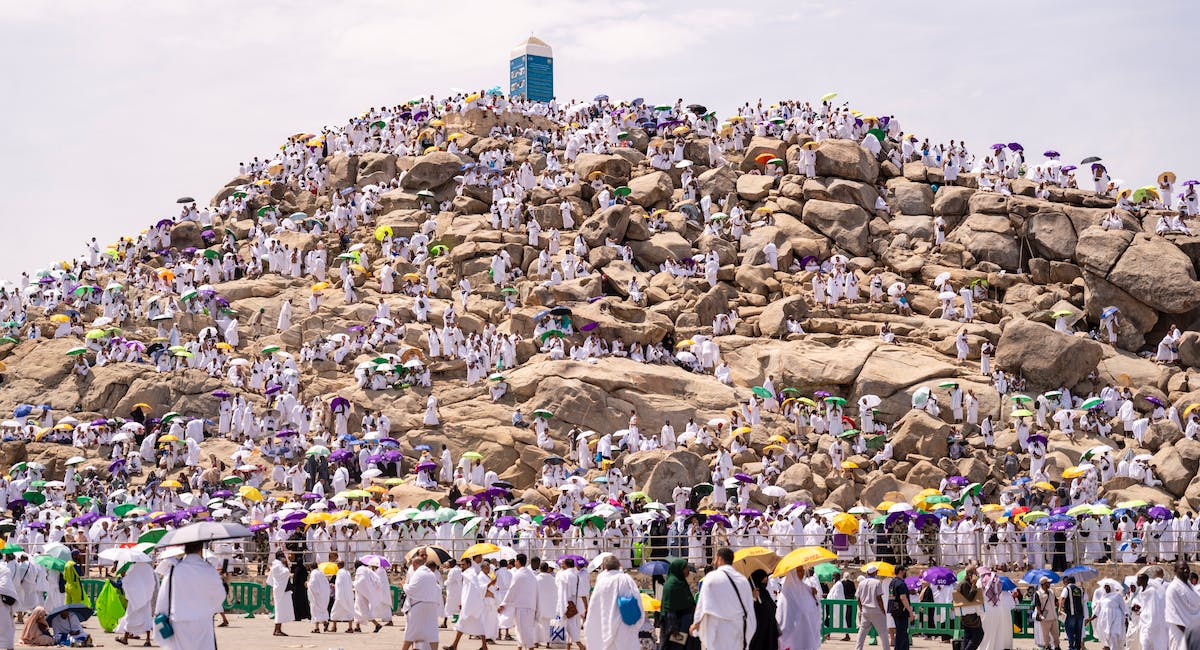
Arafat is an expanse of land where pilgrims come together in prayerful observation before Allah in order to seek His forgiveness and mercy.
This day of Arafat marks the pinnacle of their pilgrimage journey and represents humanity gathering before its Creator for judgment; pilgrims submit themselves humbled before this great spiritual force that guides life itself.
Muzdalifah
After leaving Arafat, pilgrims travel to Muzdalifah, where they spend the night under open skies and engage in the ritual of the Stoning of the Devil – collecting pebbles for use at three pillars in Mina on day seven as part of its symbolic casting ceremony.
Eid al-Adha
The Stoning of the Devil marks Eid al-Adha, also known as the Festival of Sacrifice. Pilgrims often offer animal sacrifice as an act of devotion to Allah and give this food to those less fortunate – emphasizing principles of generosity and sharing.
Tawaf al-Ifadah
After Eid al-Adha, pilgrims return to Mecca in order to perform Tawaf al-Ifadah as part of their renewed commitment to Allah following the completion of more physically taxing aspects of pilgrimage. This act symbolizes their symbolic return to Kaaba.
Jamarat
Pilgrims return to Mina in Jamarat for another round of the Stoning of the Devil rites by throwing pebbles against three pillars representing evil and faithlessness.
This ritual symbolizes their commitment and expresses their defiance against temptation, represented by Satan himself.
Farewell Tawaf
Before departing Mecca, pilgrims perform a farewell tawaf and pay their last respects to the Kaaba.
This final act of Tawaf marks the conclusion of their pilgrimage experience and offers them an opportunity to reflect back on it while offering thanks for such a profound spiritual experience.
Why do Muslims go on hajj?
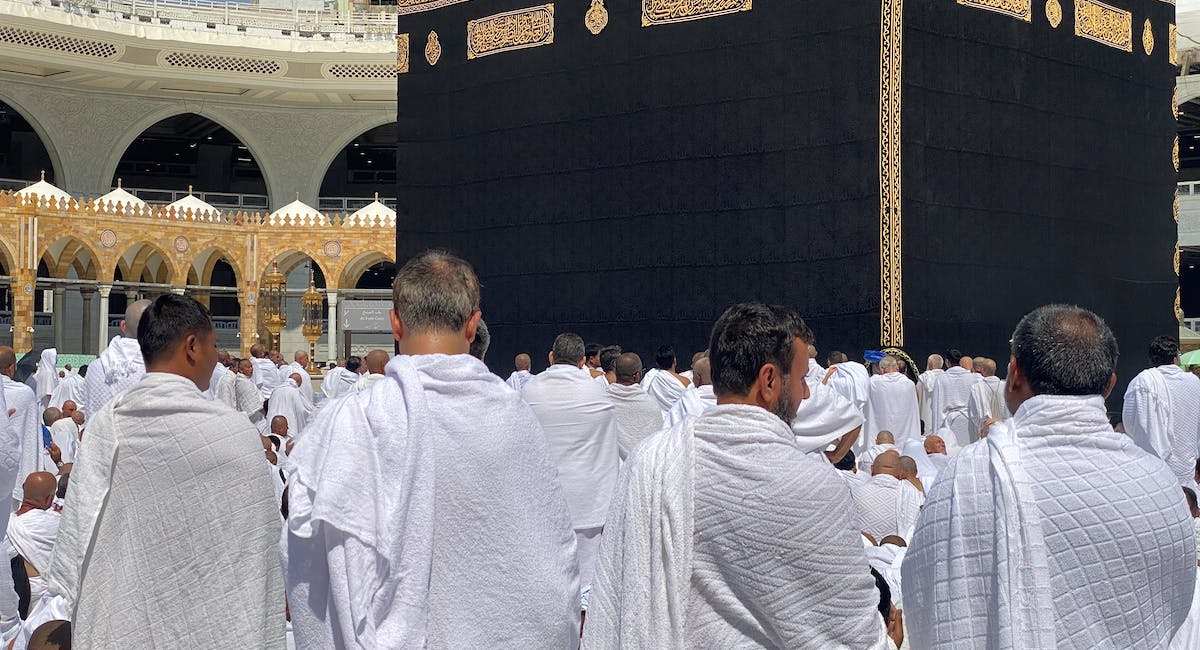
Muslims undertake Hajj as one of the five pillars of Islam and for profound religious and spiritual reasons. Hajj is deeply embedded in Islamic history, tradition, and teachings from the Quran.
Muslims perform Hajj as part of their religious duty and observance to demonstrate submission to Allah, demonstrate unity, commemorate Prophet Ibrahim’s legacy, gain spiritual purification, and gain rewards from Allah.
It holds immense meaning for millions of Muslims around the world, and their lives are forever changed as a result of participating.
Here are its primary motivations:
Religious Obligation (Fifth Pillar of Islam)
Hajj is one of the Five Pillars of Islam, which are essential acts of worship that embody Muslim belief and practice. Every physically and financially capable adult Muslim is required to undertake the pilgrimage to Mecca at least once in their lifetime.
This obligation is directly referenced in the Quran, making Hajj a sacred duty that should not be neglected.
Submission and Obey of Allah
Participating in Hajj is a way for Muslims to demonstrate their submission and obedience to Allah. It involves both physical and spiritual sacrifice, with specific rituals to observe to demonstrate an ardent commitment to doing God’s will.
Unity of the Muslim Ummah
Hajj is an important symbol of Muslim unity and emphasizes its universal nature by gathering Muslims from various backgrounds, cultures, and nationalities together at Makkah at once to perform similar rituals simultaneously. This collective act reinforces equality before God while emphasizing its universal nature.
Following the Example of Prophet Ibrahim (Abraham)
Many rituals performed during Hajj commemorate the actions taken by Prophet Ibrahim, Hajar, and their son Isma’il during Hajj.
For instance, Tawaf around the Kaaba represents their dedication to Allah, while Sa’i commemorates Hajar’s search for water in the desert.
Muslims regard Prophet Ibrahim as an integral figure within Islamic tradition and believe they should follow in his footsteps.
Spiritual Cleansing and Renewal
Hajj is seen as an opportunity for pilgrims to seek purification and renewal on a spiritual level.
They ask forgiveness for past transgressions, evaluate themselves personally, and strive to become better people through rituals that instill humility, self-discipline, and devotion in them as individuals.
Earning Spiritual Benefits
Muslims believe that participating in Hajj can yield immense spiritual rewards, including forgiveness of past sins, new beginnings, and greater intimacy with Allah.
All challenges and sacrifices involved with pilgrimage serve as tests of faith in order to gain divine mercy.
How do you prepare for Hajj?
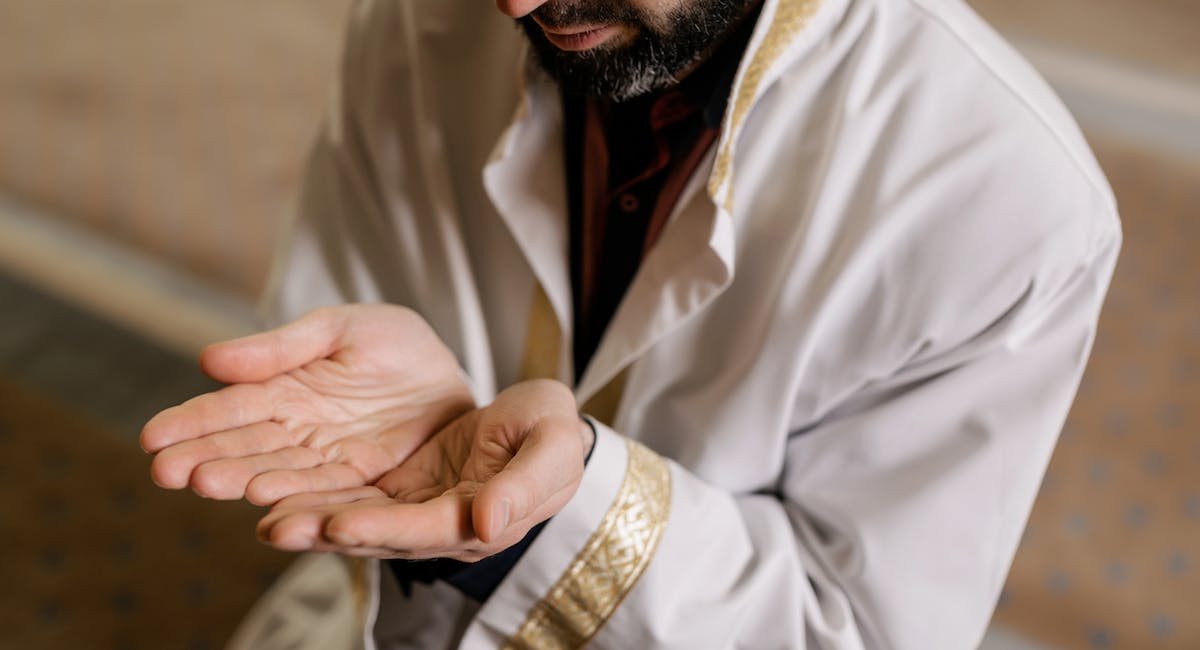
Hajj is both spiritually and physically demanding; therefore, it is highly encouraged for Muslims around the world to prepare themselves physically for it by participating in Hajj training programs.
As pilgrims can expect to walk between 5km-15km per day during Hajj, it is wise for Muslims to physically prepare for it weeks in advance so as to alleviate any sudden travel between sites over its five or six day pilgrimage journey.
Being physically prepared also provides relief from emotional and spiritual strain during Hajj.
The holy journey to Makkah, known as Hajj, requires extensive planning that takes into account logistical, spiritual, and physical aspects.
First and foremost, pilgrims need to make sure they are physically strong and in good health for the challenging rituals. This frequently entails speaking with medical experts, getting the required shots, and getting ready for any medications.
Logistically, since millions of pilgrims make the Hajj every year, it is essential:
- To plan travel and lodging well in advance.
- To understand the order of events and appropriate behavior during the pilgrimage.
- Pilgrims should also become familiar with the rites and rituals of Hajj.
- They can do this by attending pre-Hajj orientation sessions and seeking advice from knowledgeable sources.
Just as important is spiritual preparation, which includes:
- Real conversion, reflection,
- Heightened devotion via consistent prayer and deeds of kindness.
- A pilgrim’s constant prayer is to ask for forgiveness and direction on their path.
In addition, they might take care of any unpaid bills and make sure everything is in order. The Hajj is a significant spiritual work, and the experience is likely to be more fulfilling the more hard one prepares.
What is Forbidden During Hajj?
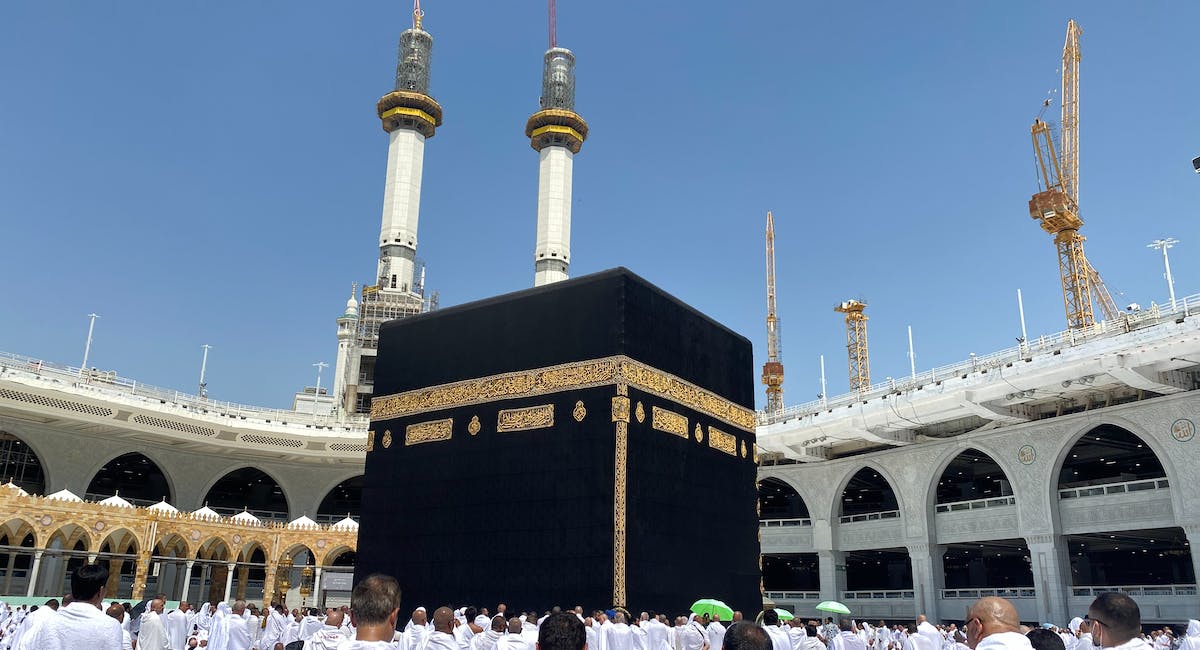
Muslims undertaking the Hajj pilgrimage must abide by a set of rules and restrictions designed to preserve its sanctity, providing a more focused and spiritually enriching journey experience. Adherence to these prohibitions is vital for Hajj pilgrims seeking to preserve its sanctity and fulfill their religious obligations in line with Islamic principles. These include:
Noncompliance With Ihram Rules
While in Ihram, the sacred state of ritual consecration worn by pilgrims during Hajj, certain actions are strictly forbidden, including:
- Cutting hair or nails
- Using perfume
- Engaging in marital relations
- Hunting.
Ihram signifies an elevated state of purity and devotion; any violation of its rules represents an attack against its sacredness.
Engaging in Arguments or Disputes
Maintaining peace and unity during Hajj is of utmost importance, which means engaging in any arguments, disputes, or violence is strictly forbidden.
Pilgrims should instead practice patience, tolerance, and understanding in order to foster an enjoyable pilgrimage experience among a diverse group of participants.
Engaging in Business Transactions
Hajj is an opportunity for spiritual reflection and devotion, so engaging in worldly affairs such as business transactions should be avoided during pilgrimage. Pilgrims should focus on their religious duties instead of distractions that may detract from their sacredness.
Harm to Living Creatures
Harming any living creature, including animals and insects, is prohibited during Hajj. This prohibition aligns with Islam’s principle of compassion and respect for all forms of life; pilgrims should therefore act responsibly so as not to compromise the well-being of both themselves and those living around them.
Men and Stitched Clothing
While in Ihram, male pilgrims are forbidden from wearing clothing with stitched stitching, opting instead to wear two pieces of white cloth that have not been sewn together; this act serves as a symbolic expression of humility and equality as all pilgrims dress alike regardless of social or economic standing.
Cover The Face for women
In order to preserve an atmosphere of modesty and simplicity during pilgrimage, women in Ihram should refrain from covering their faces with veils. This policy ensures they maintain an atmosphere of simplicity.
Engaging in Personal Grooming
While in Ihram, certain forms of personal grooming, such as:
- Shaving
- Trimming
- Trimming hair
- Trimming nails
- Use of perfumes
are prohibited as a symbolic representation of leaving worldly comforts behind and prioritizing spiritual purification.
الْحَجُّ أَشْهُرٌ مَّعْلُومَاتٌ ۚ فَمَن فَرَضَ فِيهِنَّ الْحَجَّ فَلَا رَفَثَ وَلَا فُسُوقَ وَلَا جِدَالَ فِي الْحَجِّ ۗ وَمَا تَفْعَلُوا مِنْ خَيْرٍ يَعْلَمْهُ اللَّـهُ ۗ وَتَزَوَّدُوا فَإِنَّ خَيْرَ الزَّادِ التَّقْوَىٰ ۚ وَاتَّقُونِ يَا أُولِي الْأَلْبَابِ ﴿197﴾
The hajj [season] is in months well-known; so whoever decides on hajj [pilgrimage] therein [should know that] there is to be no sexual contact, vicious talk, or disputing during the hajj. And whatever good you do, Allah knows it. And take provision, for indeed the best provision is godliness. So be wary of me, O you who possess intellects.
What do you say when someone completes Hajj?
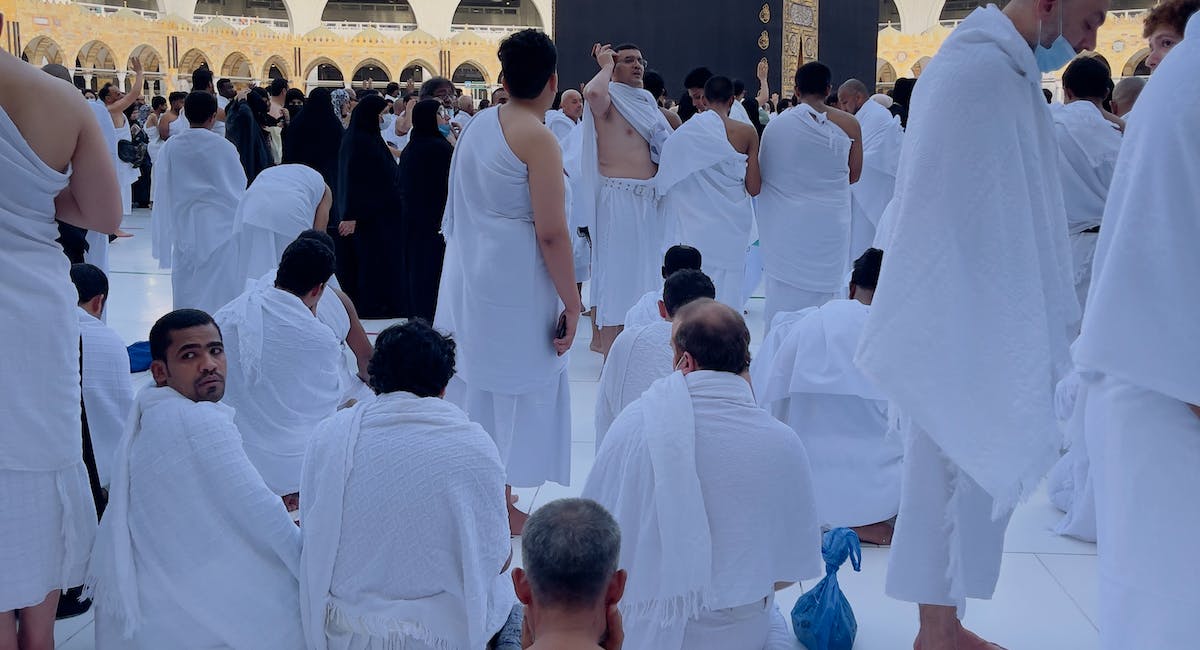
As is customary when someone completes Hajj, Muslims express their joy and acknowledge its significance by giving congratulations and saying “Mabrook” or “Mabroor.” Mabrook translates into English as congratulations while Mabroor means accepted or blessed. These terms offer well wishes and acknowledge the pilgrim’s achievement of fulfilling one of Islam’s Five Pillars.
Also, prayer for Hajj pilgrims and ask Allah’s blessing for their pilgrimage is common practice and Muslims may say:
“May Allah accept your Hajj and grant you His mercy for any sins you may have committed,”
“May Allah bless your Hajj with success!”
“May Allah grant you strength in your faith and provide an abundant bounty in return for your pilgrimage journey.”
These expressions of congratulations and prayers recognize the spiritual significance of Hajj pilgrimage for Muslims, with hopes that Allah accepts their journey and that they come home with purified hearts and souls.
What does the Quran say about Hajj?
The Quran contains several verses discussing hajj and its rules. According to God in the Quran, Prophet Ibrahim and Ismail rebuilt the Kaaba, or House of God, which Prophet Adam had originally built long ago; these men also performed hajj rituals according to what the Quran states in this regard.
وَإِذْ يَرْفَعُ إِبْرَاهِيمُ الْقَوَاعِدَ مِنَ الْبَيْتِ وَإِسْمَاعِيلُ رَبَّنَا تَقَبَّلْ مِنَّا ۖ إِنَّكَ أَنتَ السَّمِيعُ الْعَلِيمُ ﴿127﴾
As Abraham raised the foundations of the House with Ishmael, [they prayed]: ‘Our Lord, accept it from us! Indeed You are the All-hearing, the All-knowing.
رَبَّنَا وَاجْعَلْنَا مُسْلِمَيْنِ لَكَ وَمِن ذُرِّيَّتِنَا أُمَّةً مُّسْلِمَةً لَّكَ وَأَرِنَا مَنَاسِكَنَا وَتُبْ عَلَيْنَا ۖ إِنَّكَ أَنتَ التَّوَّابُ الرَّحِيمُ ﴿128﴾
‘Our Lord, make us submissive to You, and [raise] from our progeny a nation submissive to You, and show us our rites [of worship], and turn to us clemently. Indeed You are the All-clement, the All-merciful.’
وَأَتِمُّوا الْحَجَّ وَالْعُمْرَةَ لِلَّـهِ ۚ فَإِنْ أُحْصِرْتُمْ فَمَا اسْتَيْسَرَ مِنَ الْهَدْيِ ۖ وَلَا تَحْلِقُوا رُءُوسَكُمْ حَتَّىٰ يَبْلُغَ الْهَدْيُ مَحِلَّهُ ۚ فَمَن كَانَ مِنكُم مَّرِيضًا أَوْ بِهِ أَذًى مِّن رَّأْسِهِ فَفِدْيَةٌ مِّن صِيَامٍ أَوْ صَدَقَةٍ أَوْ نُسُكٍ ۚ فَإِذَا أَمِنتُمْ فَمَن تَمَتَّعَ بِالْعُمْرَةِ إِلَى الْحَجِّ فَمَا اسْتَيْسَرَ مِنَ الْهَدْيِ ۚ فَمَن لَّمْ يَجِدْ فَصِيَامُ ثَلَاثَةِ أَيَّامٍ فِي الْحَجِّ وَسَبْعَةٍ إِذَا رَجَعْتُمْ ۗ تِلْكَ عَشَرَةٌ كَامِلَةٌ ۗ ذَٰلِكَ لِمَن لَّمْ يَكُنْ أَهْلُهُ حَاضِرِي الْمَسْجِدِ الْحَرَامِ ۚ وَاتَّقُوا اللَّـهَ وَاعْلَمُوا أَنَّ اللَّـهَ شَدِيدُ الْعِقَابِ ﴿196﴾
Complete the hajj and the ‘umrah for Allah’s sake, and if you are prevented, then [make] such [sacrificial] offering as is feasible. And do not shave your heads until the offering reaches its [assigned] place. But should any of you be sick, or have a hurt in his head, let the atonement be by fasting, or charity, or sacrifice.
And when you have security—for those who enjoy [release from the restrictions] by virtue of their ‘umrah until the hajj—let the offering be such as is feasible. As for someone who cannot afford [the offering], let him fast three days during the hajj and seven when you return; that is [a period of] ten complete [days]. That is for someone whose family does not dwell by the Holy Mosque. And be wary of Allah, and know that Allah is severe in retribution.
Hajj in Quran: The State of Ihram
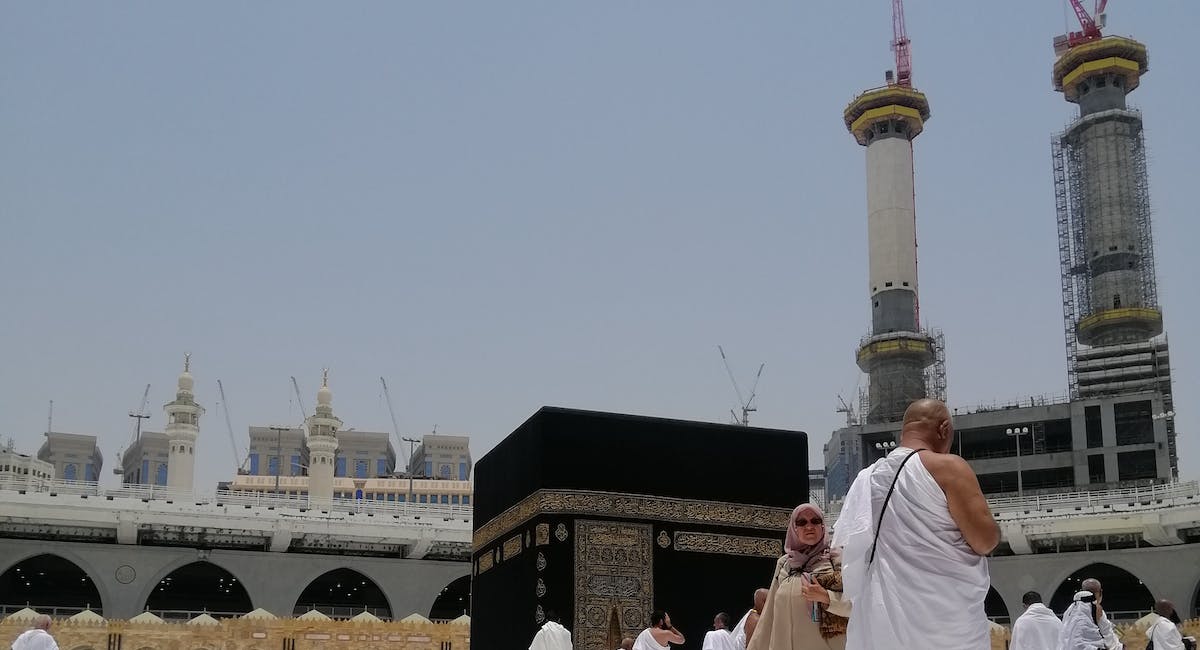
As part of their hajj rituals, when individuals want to begin the hajj pilgrimage they must first enter into an Ihram (Hrm), or muhrim state; this term derives from Harm (Harm), which translates to forbidden or sacred. Certain items or actions become off limits for muhrim in order to respect and observe the sacredness of hajj, Masjid al-Haram (masjid-al-lHarm), and Kaaba.
Pilgrims must become muhrim in specific locations known as miqat (myqt), which are several kilometers from Masjid al-Haram. After being muhrim in these places known as miqat (myqt), pilgrims must don Ihram clothing consisting of two pieces of white cloth that resemble towels; one piece worn on the lower body known as an “izar (zr) and another on their upper bodies known as rida’ (rid).
However, only men must donning this attire whereas women usually wear clothes of similar color so as not to stand out in any particular way from men who typically put on these. After wearing Ihram clothing, individuals must say Talbiyah; that is to say:
لَبَّیكَ الّلهُمَّ لَبَّیكَ، لَبَّیكَ لاشَریكَ لَكَ لَبَّیكَ، إنَّ الْحَمْدَ وَ النِّعْمَةَ لَكَ وَالْمُلكَ، لاشَریكَ لَكَ لَبَّیكَ
Labayk in a nutshell means, “Here I am O God, here I am ready to obey you.”
Surah Hajj in Quran
There is an entire chapter in the Quran titled Hajj. This surah is the 22nd surah of the Quran that God revealed to Prophet Muhammad in Medina. Starting from verse 26, the topic of hajj begins. Verse 26 states:
وَإِذْ بَوَّأْنَا لِإِبْرَاهِيمَ مَكَانَ الْبَيْتِ أَن لَّا تُشْرِكْ بِي شَيْئًا وَطَهِّرْ بَيْتِيَ لِلطَّائِفِينَ وَالْقَائِمِينَ وَالرُّكَّعِ السُّجُودِ ﴿26﴾
When We settled for Abraham the site of the House [saying], Do not ascribe any partners to Me, and purify My House for those who circle around it, and those who stand [in it for prayer], and those who bow and prostrate themselves.
Prophet Ibrahim was a prophet who introduced people to monotheism. According to various accounts, Adam originally constructed the Kaaba.
But after many centuries passed without anyone tending to it or any sign that it existed at all, Prophet Ibrahim rebuilt it under God Almighty’s order and purified it of any idols brought around for circumambulation (Tawf).
God instructs Prophet Ibrahim to pray standing, bowing, and prostrating before Him – similar to how Muslims pray today – which leads us to understand that Prophet Ibrahim likely worshiped facing Kaaba as his place of worship at that time.
Why does Allah invite you to Hajj?

Hajj is one of the Five Pillars of Islam and forms the core of faith and practice for Muslims worldwide.
Allah encourages Hajj as part of their religious duty and worship practice, while the Quran (which many Muslims consider the word of God revealed to Prophet Muhammad (peace be upon him) emphasizes its significance and encourages pilgrims to undertake it under certain conditions).
One of the primary reasons behind Allah’s call to perform Hajj is its emphasis on obedience and submission; performing Hajj serves as an act of faith, submissively accepting His will by adhering to its commands.
Hajj is also an opportunity to highlight values of unity and equality within the Muslim community, uniting Muslims from diverse backgrounds regardless of ethnicity, race or social standing – with Allah viewing each Muslim equally. It fosters an immense sense of brotherhood.
Hajj is an act of spiritual renewal. The rituals performed during pilgrimages symbolize purification and ask forgiveness for past transgressions; pilgrims participate in repentant acts with hopes of renewing their spirit and starting over on their faith journeys.
Hajj is also renowned for strengthening community bonds. Pilgrims from all around the globe come together to fulfill this religious obligation and strengthen bonds within the global Muslim community through worshiping at sacred sites of Hajj.
Experiencing worshiping at these same holy spots creates lasting bonds among believers that continue even after Hajj ends.
Hajj draws its inspiration from Prophet Ibrahim (Abraham) and Isma’il (Ishmael).
Muslims believe these prophets played an essential role in building Kaaba, and its rituals commemorate their obedience and sacrifice as an act of commemoration that allows Muslims to follow in their noble footsteps.
How many days is Hajj?
Hajj usually takes five days to complete. Beginning on the 8th day of Dhu al-Hijjah the final month in the Islamic calendar and concluding 13th day, Eid al-Adha begins which lasts three days when a new crescent moon is sighted.
When that occurs Eid al-Adha commences and Hajj which includes a series of rituals including:
- Tawaf (circumambulation) around Kaaba
- Standing at Arafat plain
- Aymbolic stoning of devil
- Animal sacrifice etc
marking completion and spiritual significance in Mecca itself and Islamic spiritual significance beyond.
- Facts about Hajj
- One of the Five Pillars of Islam is the Hajj, which every Muslim who is able to afford it and is physically fit must perform at least once in their lifetime. It represents obedient submission to Allah and devotion to Him.
- All pilgrims wear basic white clothing during the Hajj, doing away with distinctions based on nationality, wealth, or status. This emphasizes humility and unity by symbolizing the equality of all Muslims before Allah.
- The Prophet Ibrahim (Abraham), his wife Hagar, and their son Isma’il (Ishmael) are honored in the Hajj rituals. The steps taken by Hagar in her search for water and Ibrahim in obedience to Allah’s will are implemented by pilgrims.
- Tawaf, or circling the Kaaba seven times, is a ritual performed by pilgrims to symbolize the unity of the Muslim Ummah and Allah.
- Pilgrims affirm their rejection of evil influences and their resolve to resist temptation by symbolically building stone pillars that represent Satan.
- In observance of Ibrahim’s readiness to sacrifice his son at Allah’s command, pilgrims carry out Qurbani, the ritual of offering an animal.
- The Hajj is finished when Eid al-Adha, the Festival of Sacrifice, is observed. This festival is characterized by group prayers, feasts, and the sharing of sacrificial meat.
- Muslims from all over the world gather for the Hajj, which strengthens their sense of community. During this yearly pilgrimage, people from all languages, cultures, and backgrounds come together in Makkah.
- Pilgrims develop patience, humility, and thankfulness during the Hajj, which promotes spiritual development. It provides an opportunity for reflection, repentance, and a revitalized dedication to leading an upright life.
Conclusion
In Islam, the Hajj is a major pilgrimage that lasts five days, usually beginning on the eighth day of the Islamic lunar month of Dhu al-Hijjah and ending on the thirteenth. The precise length of time, however, might change depending on when the new crescent moon appears, indicating the start of Eid al-Adha. Eid al-Adha begins and the Hajj pilgrimage ends when the new moon is sighted.
Pilgrims perform several rituals over these five days, such as the ritual of animal sacrifice, the symbolic stoning of the devil, and Tawaf, or walking around the Kaaba. The pilgrimage’s spiritual fulfillment is indicated by the completion of these rites.
Over the course of the four-day celebration known as Eid al-Adha, or the Festival of Sacrifice, pilgrims frequently offer animal sacrifices to Allah as a sign of their devotion and distribute the meat to the less fortunate, highlighting the values of sharing and charity.
Depending on when the new moon is visible, the entire Hajj pilgrimage, including Eid al-Adha celebrations, lasts for approximately nine to ten days. The core pilgrimage lasts roughly five days.
FAQ’s
Why Hajj is important?
One of the tenets of Islam is the hajj, which every Muslim must perform once in their lives. Muslims believe that by completing this physically taxing trek, they might atone for their past transgressions and begin anew before God. During the Hajj, pilgrims aim to strengthen their religion; some women choose to don the “hijab,” a head covering.
What is tawaf in hajj?
Tawaf is a respected Islamic ceremony that entails walking around Mecca, Saudi Arabia’s sacred landmark, the Kaaba. Tawaf is considered a significant component because it shows the unity of Allah’s devotees, who come to His house to worship in unison from all over the world.
What is muzdalifah in hajj?
For those performing the Hajj, Muzdalifa, in Saudi Arabia, is an essential place to spend the night. This site is important to the Hajj rituals. When pilgrims arrive in Muzdalifa, they combine the Maghrib and Isha prayers, reducing the length of the Isha prayer to two rakats. In Muzdalifa, pilgrims also gather stones for a ritual known as “stoning the devil.”
Who performed first hajj in Islam?
After constructing the Kabba, Prophet Ibrahim and his son Ishmael A.S. carried on the first Hajj.
How many times the word hajj appears in the Quran?
In multiple Surahs, including Surah al-Baqarah, Surah al-Maida, Surah Imran, Surah Fath, Surah Hajj, and Surah Tawba, Allah SWT makes reference to the Hajj about twelve times in the Quran.
Can you go to Hajj without a mahram?
Islamic law mandates that women must do the Hajj under the supervision of a male guardian, known as a mehram, who can be a father, brother, spouse, or son. The purpose of this regulation is to protect female pilgrims’ safety and wellbeing. It can be difficult for a woman to do the Hajj trip without a mehram.
Which pillar of Islam is hajj?
The fifth pillar of Islam and the most prominent example of Islamic unity and faith worldwide is the Hajj, or the journey to Makkah.

